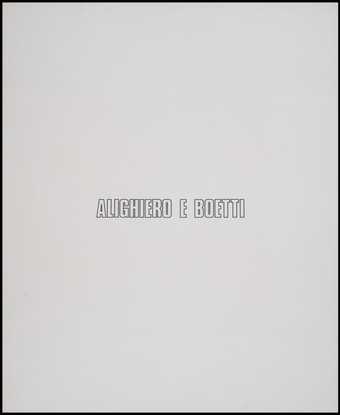Alighiero E Boetti was a key member of the arte povera group of young Italian artists in the late 1960s which was working in radically new ways using simple materials. Here, curator Mark Godfrey, walks us around the Boetti exhibition at Tate Modern.
Alighiero Boetti was an artist who was born in Turin in 1940. He moved in the seventies to Rome, but he spent significant parts of his career travelling in places like Afghanistan and Japan. A lot of his work is made with embroidery, drawing, all sorts of different kinds of materials. He was also interested in lots of systems of knowledge, in classifications and sequences.
We have the very first map that Boetti had embroidered in Kabul, and it was done by women embroiderers working at the Royal College of Needlework in Kabul. And what is special about this particular map is that the stitching in it is different from all the ones that were made later. This map was done with the Bokhara stitch, which is very, very time-consuming. Each loop threads through the previous one.
And up on the wall, a work from the first show that Boetti had in early ’67, a work called Ping Pong, and the work produced is a visual oscillation back and forth, ping pong, ping pong, and I think that back and forth goes throughout his work, especially where he thinks about relationships of order and disorder.
Rather than wanting simply to oppose order and disorder, he wanted to use the processes of ordering and disordering as a way of making artworks. He would take sheets of grid paper and then set himself the task of going over each line in the grid paper only once. And in this work, he was exploring ideas of time wastage, and also ideas of inefficiency. The quickest way to go over all the gridlines was just to go down the verticals and across the horizontals – he hasn’t done that. And in each sheet, he has found a different way to cover up all the lines.
Boetti made many works using envelopes and the postal system. He was often interested in playing with the colours of stamps. This is the first work where he did this. He used three different coloured stamps in all their permutations, and to exhaust the permutations, he had to use six envelopes. At a later point, he would go up to seven different colours of stamps, and that required 5,040 different envelopes.
I’m standing next to one of Boetti’s last works, his self-portrait from 1993, and Boetti cast himself, and he’s holding up a hose, and the hose is pouring water onto his head. As the water hits his head, it boils off and a cloud of steam rises up from his head. And it’s an amazing self-portrait which images the artist as a thinker with so many ideas that he needs to cool his head down.
If you look around the most exciting artists practising in the world today, they are all really, really fascinated with Boetti, and they take different ideas of his in different directions, whether it’s to do with time wastage, whether it’s to do with geopolitics, or whether it’s to do with working with crafts people; so many different artists are united in their admiration for Boetti.
End of recording

